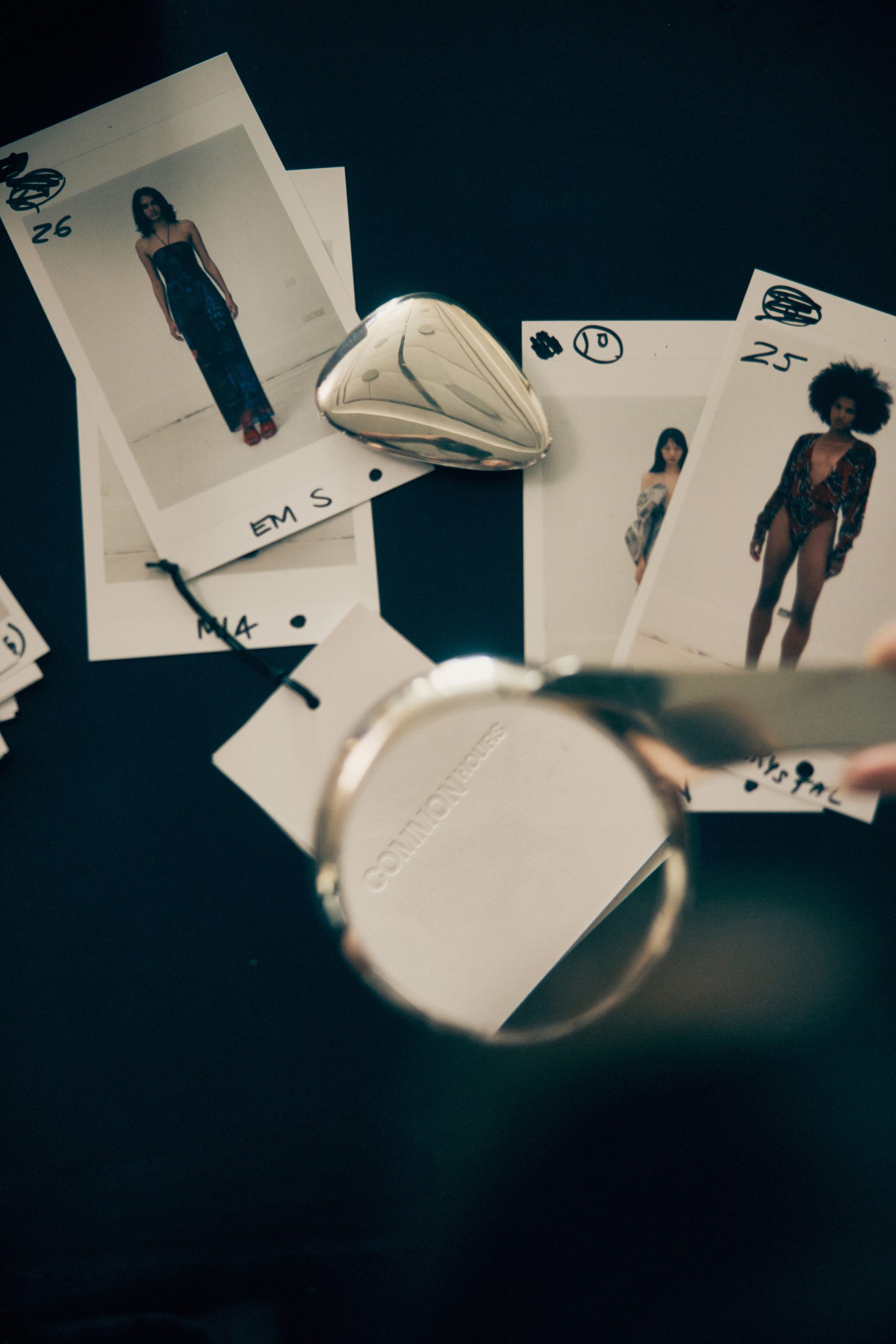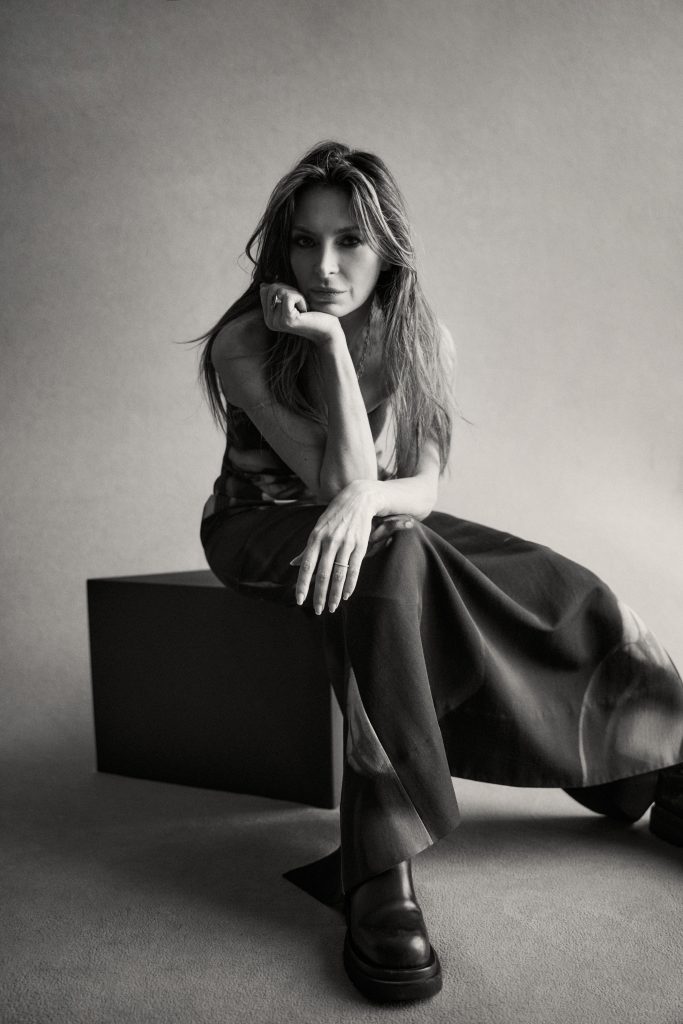—Words Glynis Traill-Nash
—Photography Georges Antoni
Fashion label founder Amber Symond shares how art, music and personal memory inspire her designs, home and business.
A signed, first-edition 1929 copy of Virginia Woolf’s A Room of One’s Own sits atop a pile of books on a leather-topped desk. Behind it, expansive bookshelves are filled with more rare reading material; novels by the likes of Jane Austen and the collected works of Oscar Wilde, along with coffee-table books covering the gamut of art, design, fashion, architecture and photography. Bold names leap out from supine spines: Richard Avedon, Tom Ford, David Bowie, Yves Saint Laurent, Frida Kahlo. For Amber Symond, this room is a beloved corner of the harbourfront mansion in Sydney’s Point Piper that she has shared for a decade with Aussie Home Loans founder John Symond, from whom she formally separated in December.
A regular venue for charity events, the sprawling Wingadal Place home is famed for the art collection woven throughout. The library room’s appeal is exponentially enhanced by a number of paintings by iconic Australian artist Brett Whiteley, for instance. On one wall, a large work backed in cobalt blue featuring an unfurled frangipani and a hummingbird; on the facing wall, a scene of bathers on the beach in Byron Bay. A smaller frangipani painting hangs to its right. Sitting on a teal velvet sofa beneath the cobalt painting, Symond says she feels authentically herself in this space. “It’s just the energy of the room. It’s a quiet, relatively dark space in an otherwise very bright house. It feels like a safe environment, where I am surrounded by books and music.”


The soundtrack in the background of our conversation happens to be laid-back— the Rolling Stones’ Miss You and a remix of Neil Young’s Harvest Moon for starters. She says it’s probably a playlist from one of her two teenage children. But on another day, her own choices might include baroque or indie, including The Jesus and Mary Chain or The Cure. “I am attracted to the music of my youth, which is more punk and alternative, because it is particularly jolting… but I also love classical music. My tastes are quite diverse and forever evolving.”
Beyond the library hang modern works by Andy Warhol, Banksy, Jeffrey Smart, John Coburn, Lynn Chadwick and a particular favourite, Columbian artist Fernando Botero, whose rounded figures feature on walls and in sculptures. “I find any kind of art mood-altering, but particularly music and literature,” says Symond, adding that art offers much of the inspiration behind her luxury fashion label, Common Hours.
Launched in 2019, the brand is something of an anomaly in the Australian fashion industry. The price point—which ranges from $750 to $10,000, with many of its signature robes sitting around the $5000 mark—naturally narrows the field of consumers, but the brand is about more than catering to high-earning fashion lovers. The ideal customer is a collector of sorts: “someone who cares about the rare”.
There is a distinct sense of intimacy to the garments, for both Symond and the wearer. “Hidden details are an important component,” she says. “At first glance a lot of our garments just look like gowns or opera coats designed to drape elegantly, but on the inside you will often find musings and motifs and messages that the wearer can identify with. It’s like a tattoo almost, that’s just for yourself. It’s tongue in cheek with a sense of irreverence but could also be something personal.
“It’s certainly personal for me; everything I make is very personal.”
Some pieces are reversible, allowing those internal musings to be put on show to the world. “I loved the idea—the almost silent or provocative protest—that you could have a riot inside that might be for yourself, but on the outside, it could look perfectly reserved and restrained and elegant. Or you could reverse it,” she says.


When we meet Symond wears the kimono-style Music and Dance robe from her first collection, featuring the jazz-era performer Josephine Baker of La Revue Nègre as painted by French artist Paul Colin in the 1920s. In keeping with the brand’s ethos of scarcity and craftsmanship, it is one of just 50 produced, the maximum number of editions for any Common Hours release. “On average, we make 20 to 30 units of each piece. I don’t ever want to make more than 50 worldwide, which makes the proposition more special for our customers,” she says.
The Colin artwork was licensed as part of an elaborate process Common Hours undertakes to secure usage rights for the artworks or lyrics it incorporates into its designs. “It’s important to me because artistic skill and integrity should be respected,” Symond says of the lengths it takes to acquire these permissions from copyright holders. She cites a hooded cape made from a wool and cashmere jacquard that features Tamara de Lempicka’s Portrait of the Marquis d’Afflitto (1925), licensed via the artist’s estate. “I’ve had the opportunity to use two of [Lempicka’s] artworks that were very masculine, and was initially intrigued to see how menacing her proto-feminist imagery might appear on a dress made of suiting fabric.”
A silk-cotton robe dress from the brand is covered with lyrics from The Cure’s Pictures of You, while another gown quotes Romeo and Juliet by Dire Straits. This style of box-sleeve kimono was the starting point for the Common Hours. “They’re a great canvas to imbue with all sorts of artwork, and the design is versatile,” she explains. “You can wear it to an evening occasion, to a lunch, over swimwear, around the house; you’re only limited by your mood.” She concedes the wrapround style can also feel like personal armour to shield yourself in, which is how she approaches all fashion: “It’s an extension of how you’re feeling at any given time.”


Later in the day Symond is swathed in the Infinity and Time gown, a black leather robe that looks equal parts tough, sexy and supremely comfortable. It is delicately embroidered with constellations and blossoms by the Chanakya embroidery house in Mumbai, the same artisans used by some of the world’s leading luxury houses including Schiaparelli, Valentino and Christian Dior, the latter having recently showcased Chanakya craft in a dedicated runway show. “To be an Australian brand collaborating with international artisan communities of such skill and savoir-faire is remarkable,” she notes.
Fabric sourcing and development, largely undertaken with the best mills in Europe and Japan, is also an involved process. Often the fabrics are traditional natural fibres such as silk and wool, but Symond also explores technical fabrics to create different effects. “It takes a lot of time to make these garments, sometimes 45 days just for the hand embroidery. They sometimes go through many, many hands, from dip-dyeing and milling to embroidery for example. And we do most of our making in Australia for hand-cutting and the placement of artwork prints to make sure they render perfectly across the seams.”
This is one of the reasons that Common Hours releases no more than two collections each year, working against the increasingly fast pace of the global fashion industry, where brands often release four to six collections a year, or more. “I’m very respectful of the industry, but [the brand] just seems to have organically developed, and we’re going to stick to the authentic mode of what we do.”
As she descends the home’s central staircase towards a French silver candelabra, Symond’s gold Headline trench dress billows out behind her. The light-as-air silk lamé printed in Italy with Australian newspaper clippings from from 1971—the year Symond was born. The liquid gold dress is from the current AlleyCat collection, which has a direct lineage to another personal chapter in Symond’s life. “Each collection has a different theme, or a memory or mood, and this time I was reminiscing about my childhood. My parents had a wine bar in North Sydney in the ’70s. They’d pile us into this Kombi van in the evening, because we lived on the Northern Beaches, and we’d go back and forth.”



Bands, such as INXS-prequel the Farriss Brothers, would play inside the bar as its patrons spilled into the alleyway outside. While they were meant to be sleeping, Symond and her sister often watched these goings-on, wide-eyed, from the windows of the van. “It was this come-as-you-are nocturnal scene where all these fantastic characters would converge,” she reminisces. “The sort of gloss of these women, their [thick] mascara, the way they didn’t care if a shoestring strap slipped down one shoulder, the sense of freedom, of defiance… I was completely fascinated.”
That same ‘gloss’ theme plays out in the AlleyCat collection with wet-look coated jersey in dresses that skim the body, and the stretch PVC of a ruched red dress that zips up and down the back, while stretch lace plays peekaboo in bodystockings and halterneck dresses. A sketch of an alley cat by collaborating artist Judd Shoppee, stitched by Chanakya embroiderers, runs down the leg of a cream silk slip dress, while lyrics from The Motels’ Total Control are scrawled in graffiti-style text along the arms and skirt of a blue mesh sheath.
This mix of rock ’n’ roll with fluid elegance is part of the appeal of Common Hours. When Symond pairs chunky black boots with a dress of delicate mesh featuring metallic specks (one of only five such textile pieces sourced from the Hurel heritage mill in Paris), then drapes herself over a Clive Murray White sculpture for the photographer’s lens, it all seems to strangely make sense.
The brand was stocked by Matches its first three seasons and is now available at Lane Crawford in Hong Kong. But the discerning customer is more likely to meet the brand—and Symond—at a private trunk show in one of two showrooms in Sydney or London. “It’s that very private, one-on-one offering,” Symond explains. “Luxury is being able to take the time to talk through a library of possibilities and themes, and it’s a delight for me to see how different people wear their garments or what they’re drawn to.”
Seeing people enjoy the finished garments is a thrill for Symond. “What starts as the germ of an idea might take over a year to become a garment that can be worn out in the world,” she says. “And it is quite remarkable to create that moment and unearth further inspiration along the way.” She will not divulge details of the next collection (anticipated in June), except to say that it is “quintessentially Australian,” adding that it will be “great fun to bring it home”. No matter where she finds her inspiration, or in what art form, Symond is approaching the future of Common Hours with an expansive mind: “I want to take more risks and stretch creatively. To elevate a new idea and push myself further in each collaborative project is really exciting.”
